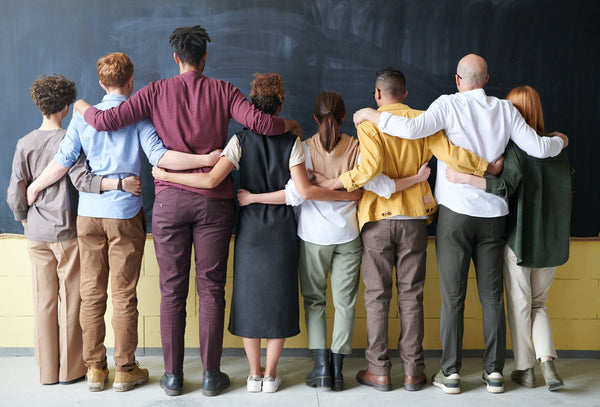
Educators have experienced many changes during this COVID-19 pandemic, from uprooting their classrooms, to job uncertainty, to coordinating virtual lessons for students, and managing the shifts in their own homes. We wanted to know how our nation’s educators were coping, so we asked teachers around the world to share their experiences.
A quick goodbye
Everything happened so quickly, and for many of the teachers we interviewed, they anticipated more time with their students or thought that, at the very least, they would have had an opportunity to say goodbye.
“The school year ended so abruptly,” one educator shared. “I feel it for all of our students, but especially our seniors who are missing the right to prom and walking at graduation.”
School closures in the United States affected nearly all of the nation's educators as well as 56.6 million school-age children. What began as a two- to three-week school closure has spread into April and, for many states, will remain in effect through the remainder of the school year.
Another educator told us, “I didn’t get to properly say goodbye to my students, and it was hard. And now, we are here, trying to navigate this ‘new normal’ of virtual classrooms, and it has many of us wondering, What will happen next?”

Going virtual
Throughout social and teacher groups, there has been an outreach from educator to fellow educator, sharing ideas, offering support, and asking, “How are you doing?”
One educator shared, “No one ever expected to experience a pandemic in a school system. We are doing our best, but it isn’t easy.”
Many educators have turned to virtual teaching, but this shift brings new challenges, leaving teachers feeling a mix of emotions.
“Going virtual takes planning and training, and we didn’t have time for that. The pain is felt in the loss of time with our students, and the steep learning curve required in navigating this pandemic so that it can work for our students, and our own families,” said one educator.
Another shared, “I think I may go crazy if school doesn’t go back to brick and mortar! I record my lessons at night, grade in the morning, and do my live videos to go over homework during the day. I don't get to bed until almost midnight and get up by 6 AM.”
Many teachers are hosting virtual learning in addition to meeting the needs of their own children, who are now home too. “It is tough trying to work with a toddler running around and there are so many virtual meetings. And every meeting is like a peek into my home. Let me tell ya, my house isn’t all that perfect, either,” another educator told us.
Despite the challenges, teachers are finding new ways to connect with their school community.
An educator shares, “What keeps me going during this time is that I have been making videos for my students, and we also have our own Instagram page for the families, too. We try to keep it fun by offering yoga, storytime, and nature walks, in addition to the academics.”
A music teacher told us, “I am just providing laughs and music enrichment for anyone I can reach and pretty much-considering band over for the year.”
A pre-school teacher shared, “Five hours, 35 houses and several tears later, and I have officially delivered all my kiddos a goodie basket. It may have been a long day but it was 100% worth it to see all their smiling faces, even if it was just through a window. I get so attached each year to all of them and their parents so it was extra emotional but nice to say hi & bye!”

Looking ahead
We asked educators what their biggest concerns were in returning to the classroom post-pandemic and this is what they had to say:
Routines
Helping their students re-transition into school rituals after months at home was a concern shared by several educators. One teacher said, “Getting our students back on a school schedule will take time … and patience.”
And, many teachers admit that it will be an adjustment for them, too. “I will have to actually change out of my jammies and put on a bra,” quips one educator.
Another added, “I am going to have to get used to holding my bladder and eating at designated times again. I won’t be able to pee and eat whenever I want!”
And several collectively agreed, “Our sleep schedule! We will have to get used to waking up early again. And, of course, our students will, too.”
Fear of hygiene
Several teachers shared that they feel concerned that their students will fear closeness, germs, and getting sick.
One teacher asks, “Will everyone look at me like I have cooties because I lost a family member due to COVID-19? It all feels so uncertain.”
Another shares, “The thing that hurts my heart most is not being able to give a student a hug or smile, especially because that is the one thing that they need at this time. We all need connection.”
Social-emotional
Many teachers expressed that the children were their biggest concern. “How will this time of staying home affect them emotionally and behaviorally, and how can we help them adjust?” asks one educator.
“Some of our students rely on public schools for consistent meals, love, and safety. I think about those students daily and pray for their wellness,” shares another.
Another teacher admitted, “Don't get me wrong, I'm sure every child is going to have a bit of anxiety leaving home, but so am I. This will be something to work through together.”
Behaviors
The educators interviewed felt concerned about how the stress of this time will influence classroom behavior.
One teacher shares, “for there to be an effective learning environment, we must address the stress and trauma. We are all experiencing some level of trauma due to COVID, and as educators, this will be an important piece of addressing any behaviors we may see.”
A special education program coordinator shares her concerns about her special needs students, “I worry about our non-verbal students, our ‘behavioral’ students, and our families who struggled with their kids when they only had them a few hours a day.”
A school therapist shared, “With school being out for an extended period of time, I worry about students' IEP goals. I feel concerned that they will have lost progress on their goals despite us reaching out and trying to assist virtually.”

Educators nationwide are banding together to navigate the pandemic. “We want families to know that we are all trying our best to provide normalcy, not only to our students but also to our families.” Whether virtually, or in the classroom, teachers are doing what they have always done - teaching from their heart for the well-being of their students.
To the teachers of the world, thank you. Thank you for teaching and guiding our children during this time. We know it is a challenge and yet we see you forging forward in so many different ways. You are molding minds and expanding hearts.
_____________
Generation Mindful creates educational tools, toys, and programs that nurture emotional intelligence through play and positive discipline. Join us and receive joy in your inbox each week.





Leave a comment